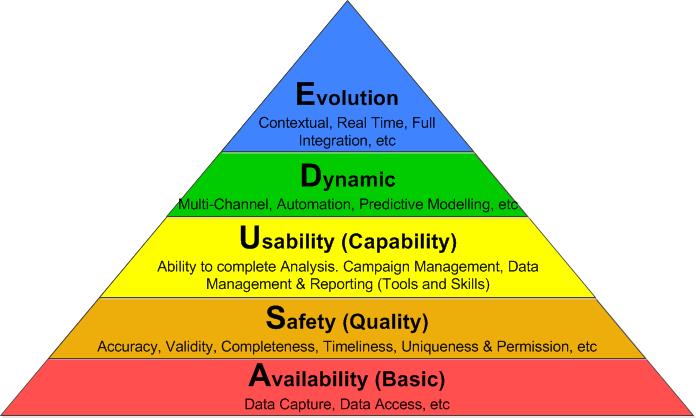Maslow’s Hierarchy of Needs
This year sees the 70th anniversary of Maslow’s Hierarchy of Needs*1. I decided to apply this approach to Database Marketing, showing the journey from the basic capability to the future of fully integrated, contextual and real-time capabilities.
The model proposes that human needs will evolve one level at a time, starting with the basic needs (or physiological needs) for survival and progressing towards self-actualisation, classically represented in the following pyramid:
The following hierarchy shows my interpretation of a hierarchy of needs for Database Marketing (ASUDE):
The preceding hierarchy shows the increasing level of sophistication required to meet your Database Marketing needs as you move towards a fully integrated real time solution.
- Availability – Starting with the basic requirement of needing data, which requires information to be captured, stored and then made accessible. This is the corner stone of any Database Marketing solution and without it the other levels become redundant (becoming broadcast advertising to no specific customer or prospect).
- Safety – Availability of data is critical, but without quality the value and usefulness of the data is limited and can be damaging and not cost effective when communicating to customers. To ensure progression to the next level, data will need to be managed to ensure:
- Accuracy – correction of misspelt information (e.g. misspelt street name).
- Validity – identification of valid details (e.g. email address format).
- Completion – ensure all necessary information is provided to give a complete contact channel (e.g. missing town details).
- Timeliness – validation of data, to ensure information provided is current and up to date (e.g. out of date postcode information).
- Uniqueness – identification of a single customer across multiple data sources and multiple contact channels.
- Permission – permission management, where the rules governing contact permission need to be available, understood and employed.
- Usability – Having data which is available and trusted provides the foundations of a Database Marketing solution, but to gain value the data has to be usable to deliver insight and drive communication activity. To enable this the following core components are required:
- Analytical Capability – Provide visualisation of data enabling descriptive analysis, RFM, segmentation, etc.
- Campaign Management – Enable customer engagement with relevant, timely communications to their preferred channels.
- Reporting Capability – Delivery of defined metrics on a regular periodic basis, in a format to provide insight and drive current & future initiatives.
- Single Customer View (Data Management) – Access to a unified view of your customer, with the ability to modify the information and business rules.
- Expertise – Capability through agreed best practice procedures and trained individuals.
- Dynamic – The first 3 levels provide the standard structure for a Database Marketing solution. To manage the multiple touch points a customer can utilise to interact with your business the following areas need to be available:
- Marketing Automation – ability to streamline and automate marketing activities and workflows, to increase operational efficiency and improve ROI.
- Multi-Channel Communication – enable customer interaction across a combination of indirect and direct communication channels, providing the customer with a choice of channels to interact with.
- Predictive Modelling – provision of statistical capability to predict the outcome of an activity, enabling customers with a greater likelihood to respond in positive fashion to be targeted.
- Evolution – The first 4 levels look at the productionisation of delivering a Database Marketing solution, enabling the marketing team to deliver consistent messaging across all channels and touch points. The final level looks at the continual evolution of the marketing landscape, an example is the shift in need to provide real time marketing as customers start to drive the communication and expect a conversation not just a series of messages. To achieve this requires:
- Context – The communication needs to be relevant to the current situation and need.
- Real Time – Customers are growing to expect a direct instant response to queries, requests and actions.
- Full Integration – Understanding of all interactions by a customer and responding in an appropriate way enables a relevant communication and not a blanket response.
This level needs to be continually assessed considering market forces, for example using Porter’s 5 Forces.
If you have any further questions or would like support / guidance in discovering or defining your Database Marketing solution, please contact me through the BlacklerRoberts Ltd “Contact Us” page and I will be happy to discuss your needs. You can also follow @BlacklerRoberts on twitter for further insights.
*1 – ‘A Theory of Human Motivation’, published by Maslow, A.H. (1943)



Appreciate you sharing, great post.Thanks Again. Will read on…
insurancewhisper